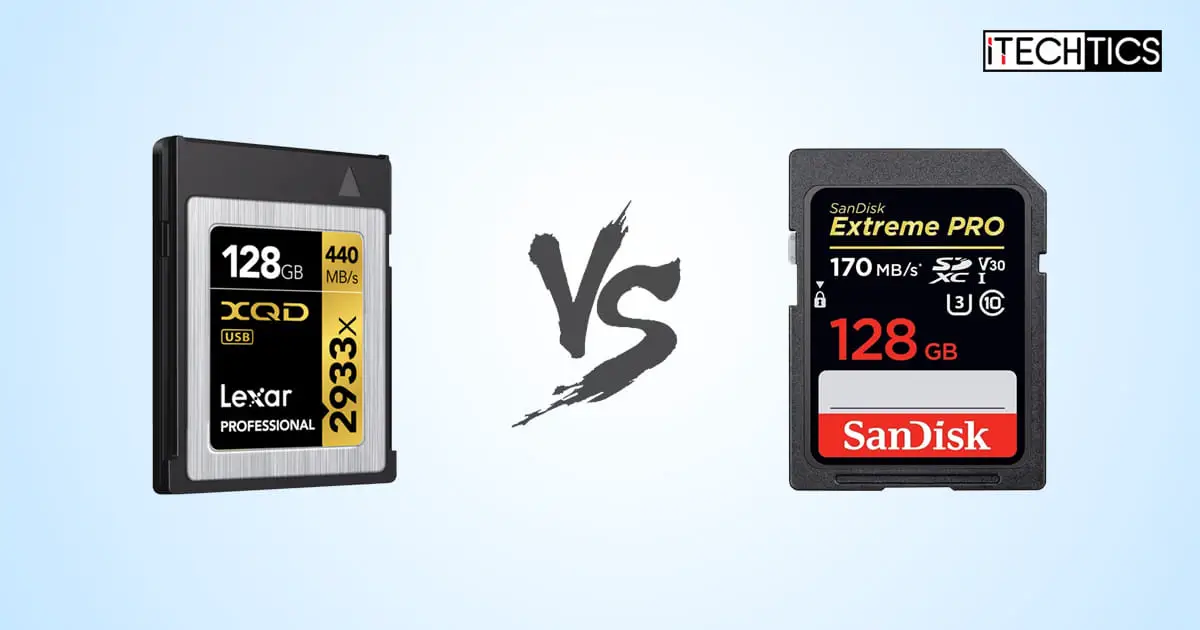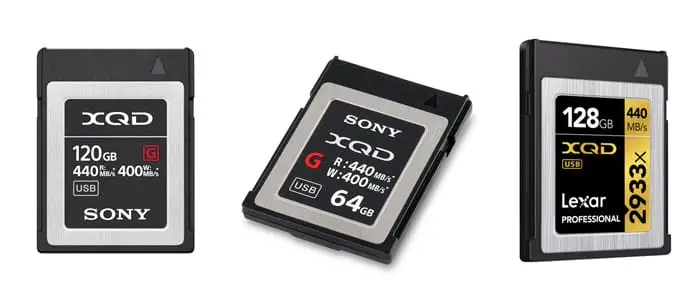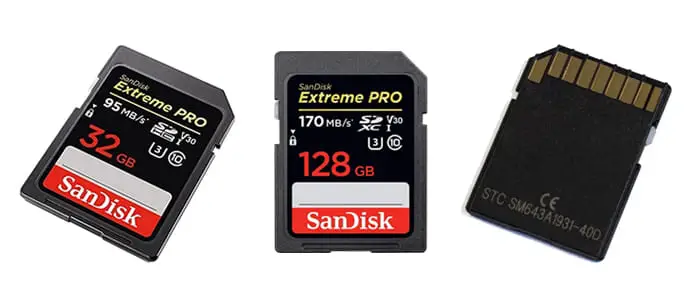It is no surprise that storage space has now become an essential commodity for everyone, from casual smartphone users to professional photographers and videographers. As technology evolves, so do the options available for storing and transferring our digital files. Two popular choices in the world of storage cards are XQD and SD cards.
While both offer ample space and fast read and write speeds, they differ in their design and compatibility, which can have a significant impact on your overall experience. Choosing the right storage card for your device is crucial to ensure data safety and accessibility.
Let’s explore the differences between XQD and SD cards and determine which one fits your needs.
On This Page
What is an XQD Card
XQD (or Express Card) is a high-speed memory card developed as a successor to CompactFlash cards. These were introduced in 2010 by Sony and are now widely used by various camera and video equipment manufacturers.
XQD cards use a PCIe interface, which allows for fast data transfer rates and makes them ideal for high-performance devices that require quick read and write speeds, such as professional cameras and camcorders.
These storage cards are built with high-quality materials, making them incredibly durable and resistant to extreme temperatures, shock, and vibration. This ensures that your data is safe and secure even in the harshest conditions.
Besides this, XQD cards come in different storage capacities. That said, you can store large volumes of high-quality data without the need for multiple cards. However, XQD cards are less commonly used than SD cards and are generally more expensive.
What makes these storage cards unique is their form factor, which is smaller than CompactFlash cards, making them more compact and portable. Additionally, XQD cards are compatible with both USB 3.0 and Thunderbolt interfaces, making it easier to transfer data to and from different devices.
Below is the list of XQD memory card series and their salient features.
| Features | XQD S Series | XQD N Series | XQD M Series | XQD G Series |
|---|---|---|---|---|
| Release Year | 2012 | 2013 | 2015 | 2016 |
| Availability | Discontinued | Discontinued | Discontinued | Currently Available |
| Storage Capacity | 32GB, 64GB | 32GB, 64GB | 32GB, 64GB, 128GB | 32GB, 64GB, 128GB, 256GB |
| Interface | PCI Express Gen. 2 Interface | PCI Express Gen. 2 Interface | PCI Express Gen. 2 and USB 3.0 | PCI Express 3.0, USB3.1 Gen.1 |
| Read Speed | 168MB/s | 125MB/s | 440MB/s | 440MB/s |
| Write Speed | 168MB/s | 80MB/s | 150MB/s | 400MB/s |
| Additional Information | First-generation XQD cards | Second-generation XQD cards | Developed by Lexar | Latest generation XQD cards |
What is an SD Card
SD, short for Secure Digital cards, are small, portable, and versatile storage devices that have become integral to modern technology. They are commonly used in devices such as digital cameras, smartphones, tablets, laptops, and game consoles, to name a few.
These cards are also available in various sizes and capacities, commonly ranging from a few megabytes to several terabytes. As a result, these can store a variety of digital data such as photos, videos, music, documents, and more.
The SD card’s popularity stems from its compact size, high storage capacity, and ability to transfer data quickly and efficiently. However, the maximum storage capacity offered by SD cards is limited to 512 GB only.
The SD card technology has evolved significantly over the years, with newer versions of the card being released every few years. The latest version of the SD card is the SD Express, which uses the NVMe (Non-Volatile Memory Express) protocol and can reach read and write speeds of up to 985 MB/s.
You can find these cards compatible with a wide range of devices, making them an accessible and convenient storage option. Furthermore, SD cards are relatively inexpensive and readily available, making them a cost-effective storage solution for many.
Here is a list of the SD card types and their salient features.
| Features | SDSC | SDHC | SDXC | SDUC |
|---|---|---|---|---|
| Release Year | 1999 | 2006 | 2009 | 2018 |
| Availability | Discontinued | Discontinued | Available | Available |
| Storage Capacity | 128MB, 256MB, 512MB, 1GB, 2GB | 4GB, 8GB, 16GB, 32GB | 64GB, 128GB, 256GB, 512GB, 1TB, 2TB | 2TB, 4TB, 8TB, 16TB, 32TB, 64TB, 128TB |
| Speed | 25 MB/s | 10 MB/s | 300 MB/s | 985 MB/s |
| Transfer Speed | 4 MB/s | 15 MB/s | 80 to 300 MB/s | 985 MB/s |
SD VS. XQD Card: Performance Comparison
The key factors that add to the overall performance include the storage card’s speed, capacity, and reliability. Here is how XQD and SD cards differ in these aspects.
Speed
In terms of speed, the XQD card takes the lead over the SD card.
XQD cards have a much faster read and write speed, making them ideal for professional photographers and videographers who need to capture high-resolution images and videos in quick succession.
The SD card, on the other hand, has a slower read and write speed, which makes it more suitable for basic photography and video recording.
Capacity
Speaking of storage capacity, XQD cards offer a wider range of options compared to SD cards. Currently, XQD cards are available in sizes ranging from 32GB to 256GB, with 1TB options also available. In the near future, we can expect even larger capacities of 2TB or 4TB to hit the market.
In contrast, the maximum storage capacity of SD cards is currently restricted to 512GB, which may not be enough for professionals who require large amounts of storage for their high-quality media files.
Reliability
One of the biggest disappointments for a photographer is losing photographs due to factors beyond their control. Therefore, ensuring that the memory card used to store these images is stable and secure is essential.
Corruption is a major threat that can either affect a few specific files or the entire card, leading to irreversible data loss. Although some software may help recover damaged files, it is always better to avoid such problems in the first place.
Additionally, some instances of corruption may not have a viable fix, making prevention all the more critical.
To ensure reliability, both XQD and SD cards are built to withstand everyday use and offer similar levels of durability. However, XQD cards are much more reliable, thanks to their exceptional ruggedness and durability, making them a more reliable option for professionals working in harsh environments.
The reason why XQD cards are ahead of SD cards is due to their construction. These are built with robust materials and designed to resist extreme temperatures, shock, and vibration. They also have a robust casing that protects the internal components from damage. Additionally, XQD cards have a specialized connector that is more resistant to wear and tear compared to the standard pins found on SD cards.
Speaking of the SD cards, these are crafted out of plastic casing and standard pins that can be prone to damage, especially when exposed to harsh conditions or frequent use. While SD cards are also designed to be durable, they may not be as reliable as XQD cards when it comes to holding out against severe conditions.
SD VS. XQD Card: Compatibility
The XQD memory card format was primarily designed for high-end professional cameras and camcorders. If you are someone who is looking for speed and performance when shooting high-resolution images or videos, XQD is the way to go. It is compatible with select high-end camera brands such as Nikon, Canon, and Sony, so if you have one of these cameras, XQD is definitely worth considering.
However, SD cards are more versatile regarding compatibility with different devices. They are compatible with a wide range of cameras, camcorders, smartphones, tablets, and even gaming consoles. In fact, these storage cards have become the de-facto standard for portable storage, with almost all electronic devices supporting this format.
That said, SD cards are the clear winner in terms of compatibility due to their universal support for various devices. Regardless of your profession and nature of use, SD cards will work with almost all of your devices. However, if you solely demand the fastest possible speeds and have a high-end camera, XQD is still the better choice.
SD VS. XQD Card: Price Comparison
While choosing the right storage card for you, make sure to understand the cost difference between SD and XQD cards. Simply put, SD cards are generally more affordable than XQD cards. The reason is the greater production size of these cards. Also, SD cards are widely used across various devices, resulting in a lower cost per unit.
On the other side, XQD cards are designed for professional-grade cameras, which means they are less commonly used and come with a higher price tag. Of course, prices may vary based on storage capacity and other factors, but if you are looking for a cost-effective option, SD cards are the way to go.
XQD VS. SD Card: Choosing The Right Memory Card
Choosing between XQD and SD cards requires careful consideration of various factors, such as device compatibility, speed, and price. XQD cards are designed for professional photographers and videographers who demand high-speed data transfer and storage capabilities. However, this comes at a higher cost.
Contrarily, SD cards offer versatility for everyday use, with a lower price point and compatibility across various devices. To make the best choice, it is important to assess your specific needs and usage patterns before investing in a memory card.
Whether you prioritize speed or cost-effectiveness, both XQD and SD cards are indispensable options for storing and transferring digital content. Ultimately, the choice comes down to what suits you best.







